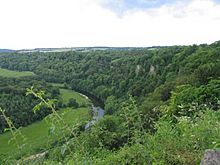Upper Wye Gorge facts for kids
| Site of Special Scientific Interest | |

The Wye Gorge from Symonds Yat Rock
|
|
| Area of Search | Gloucestershire, Herefordshire, Monmouthshire |
|---|---|
| Coordinates | 51°49′34″N 2°39′00″W / 51.8261°N 2.6501°W |
| Interest | Biological/Geological |
| Area | 245.1 hectares (2.45 km2; 0.946 sq mi) |
| Notification | 1969 |
The Upper Wye Gorge is a special place in the Wye Valley, right on the border between Wales and England. It's known as a Site of Special Scientific Interest (SSSI) because of its amazing plants, animals, and unique rocks. It's also called a Key Wildlife Site, meaning it's super important for nature. You can find it near Symonds Yat, a popular spot for visitors.
Contents
Exploring the Upper Wye Gorge
This special area covers about 245 hectares, which is like 605 football fields! Most of it (192 hectares) is in England, and a smaller part (53.1 hectares) is in Wales. It was first recognized as an SSSI in 1969.
The gorge is located about 3.5 miles (5.6 km) northeast of the town of Monmouth. Most of this area is looked after by the Forestry Commission. A part of it is also a nature reserve managed by the Herefordshire Nature Trust.
This site includes part of Lady Park Wood, which is a very important national nature reserve. The Upper Wye Gorge is also part of a larger protected area called the Wye Valley Woodlands Special Area of Conservation (SAC).
The Gorge's Ancient Geology
The Wye Gorge was carved out of two main types of rock: Old Red Sandstone and Carboniferous Limestone. On top of these rocks, you'll find many different kinds of soil. Most of the soil is alkaline (meaning it's not acidic), but some areas have acidic soil on the surface.
King Arthur's Cave: A Window to the Past
On the English side of the gorge, there are several caves, including the famous King Arthur's Cave. These caves are incredibly important because they contain ancient Pleistocene mammal remains. Scientists have found bones from animals that lived here long ago.
The oldest discoveries include bones from lions, red deer, reindeer, spotted hyenas, woolly mammoths, and woolly rhinoceroses. Later finds from colder times include tiny lemmings and steppe pikas. These discoveries also show that humans lived in these caves during those ancient periods.
Amazing Wildlife and Ecology
The Upper Wye Gorge is home to a huge variety of plants and animals. It's one of the biggest areas of natural, broadleaved woodland in the whole Wye Valley. Because of the different soils, scientists have found ten different types of woodland here!
Diverse Plant Life (Flora)
The gorge has many rare trees. You can find the large-leaved lime (Tilia platyphyllos), which is rare across the country. There are also several types of whitebeam trees, like English whitebeam (Sorbus anglica), grey-leaved whitebeam (Sorbus porrigentiformis), rock whitebeam (Sorbus rupicola), and round-leaved whitebeam (Sorbus eminens).
The most common trees in the gorge are ash (Fraxinus excelsior), common beech (Fagus sylvatica), Cornish oak (Quercus petraea), English oak (Quercus robur), and silver birch (Betula pendula).
Lower down, you'll find plants like hazel (Corylus avellana), field maple (Acer campestre), small-leaved lime (Tilia cordata), and wych elm (Ulmus glabra).
On the ground, common plants include bilberry (Vaccinium myrtillus), bramble (Rubus fruticosus), common bracken (Pteridium aquilinum), dog's mercury (Mercurialis perennis), false brome (Brachypodium sylvaticum), and great wood-rush (Luzula sylvatica). Some rarer plants found here are narrow-leaved bittercress (Cardamine impatiens), stinking hellebore (Helleborus foetidus), wood barley (Hordelymus europaeus), and wood fescue (Festuca altissima).
In the Grassland areas, you might spot the uncommon bloody cranes-bill (Geranium sanguineum). There are also rare sedge plants like dwarf sedge (Carex humilis), fingered sedge (Carex digitata), and soft-leaved sedge (Carex montana).
Amazing Animal Life (Fauna)
The gorge is home to many different mammals, including badgers and fallow deer. The caves are a cozy winter home for greater horseshoe bats and lesser horseshoe bats.
Many birds live in the woodlands of the SSSI. You might see a buzzard, nuthatch, peregrine falcon, pied flycatcher, raven, tawny owl, and the wood warbler.
The insect world is also very special here. There's a dance fly (Hilara media) and a wasp (Omalus puncticollis), both of which are nationally rare. You can also find uncommon butterflies like the wood white, pearl-bordered fritillary, and the white admiral.

